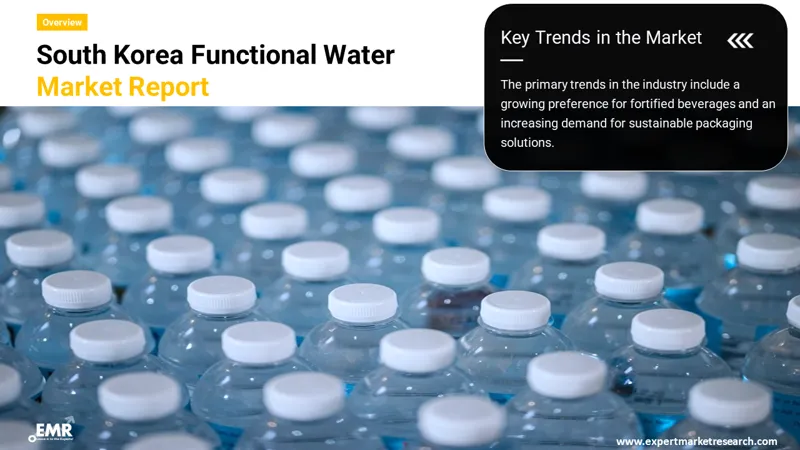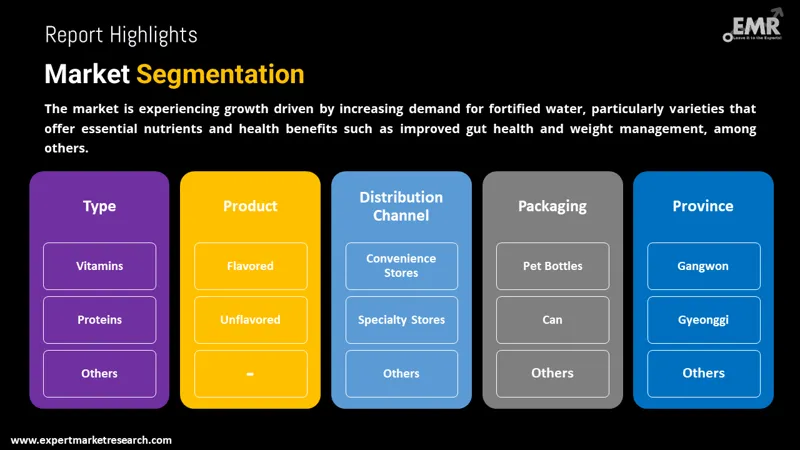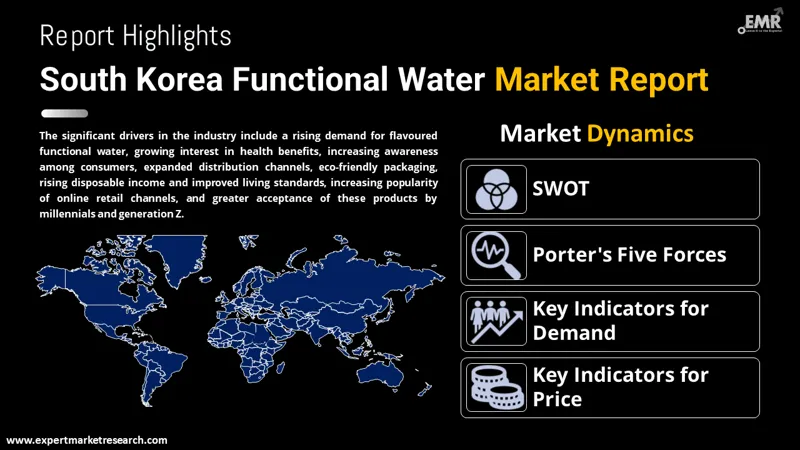Reports
Sale

South Korea Functional Water Market Share, Trends, Growth: By Product: Flavored functional water, Unflavored functional water; By Type: Vitamins, Proteins, Others; By Packaging: Pet Bottles, Can, Others; By Distribution Channel; By Province; Competitive Landscape; Industry Events and Developments; 2024-2032
South Korea Functional Water Market Outlook
The South Korea functional water market is expected to grow at a CAGR of about 3.4% in the forecast period of 2024-2032. The growing demand for fortified health beverages is expected to expand the market of functional water during the given forecast period.

Read more about this report - REQUEST FREE SAMPLE COPY IN PDF
Health Benefits of Consuming Functional Water to bolster the Market Growth
Health-conscious people who want to shift their preference from caffeine, carbonated, and high-sugar beverages are driving the functional water market. Sportspersons, bodybuilders, and marathon runners need drinks that can keep their bodies hydrated for a long time while also offering refreshment, taste, and energy. Moreover, people are willing to spend on their health and well-being, and the trend of body detoxification further propels customers to invest in wholesome functional beverages. This factor compels the manufacturers to launch more health-based products to meet the ever-growing functional water market demand.
The modern diet is deficient in many vital macro and micro-nutrients that humans require to lead a healthy life, which is why the market for functional water is still expanding. The nutrient content in the fruits and vegetables we consume nowadays has decreased over time due to soil depletion caused by over-farming. "Essential" nutrients are so-called because we must obtain them through our diet, which is becoming challenging to get from our meals in modern times. Due to its physiological benefits , particularly on oxidative stress-related disorders like diabetes, cancer, arteriosclerosis, neurological diseases, and haemodialysis side effects, functional water has attracted great interest. Moreover, functional waters enhance nutrition absorption while being easy on the digestive system. Such health benefits aid in gaining traction among health-conscious people in South Korea, thereby providing the opportunity for market growth.
Growing Demand for Fortified Drinks to Bolster the Functional Water Market
Imposed lockdown and the need to maintain social distance popularised work-from-home culture temporarily slowed down the sales of functional water in the country. However, the market is on track and experiencing gradual growth because of the rising demand for immunity-boosting and performance-boosting products in South Korea. The demand for fortified water is proliferating the market growth, especially the one which offers essential nutrients and other health benefits such as improved gut health and weight management, among others.
Market Segmentation
Functional waters are non-alcoholic and water-based beverages which are loaded with vitamins, minerals, or various infusions which provide numerous health benefits to the consumer. Natural or/and artificial flavours are often added to enhance the taste of water.

Read more about this report - REQUEST FREE SAMPLE COPY IN PDF
By product, the South Korea functional water market is bifurcated into:
- Flavoured Functional Water
- Unflavoured Functional Water
Based on type, the functional water market of South Korea can be segmented into:
- Vitamins
- Proteins
- Others
On the basis of packaging, the South Korea functional water market is divided into:
- Pet Bottles
- Cans
- Others
Based on distribution channel, the South Korea functional water market is categorised into:
- Supermarkets and Hypermarkets
- Convenience Stores
- Speciality Stores
- Online Sales Channel
- Others
On the basis of province, the South Korea functional water market can be divided into:
- North Chungcheong
- South Chungcheong
- Gangwon
- Gyeonggi
- North Gyeongsang
- South Gyeongsang
- Jeolla
- Jeju

Read more about this report - REQUEST FREE SAMPLE COPY IN PDF
Unique Flavours and Eco-Friendly Packaging Are Driving the Market Growth of Functional Water
Manufacturers have adopted sustainable design strategies in response to consumers' growing preference for goods with sustainable packaging. Functional drinks are kept safe and fresh from fill to usage owing to eco-friendly packaging. The aseptic technique eliminates the need for refrigeration. These products are shelf-stable and preservative-free. The young consumer base, especially Gen Z and Millennials, are more attracted to novel flavours, which fits nicely with young consumers' inclination for a taste exploration. Brands are now trying to see how customers react to bizarre variants to continue to excite consumers and reach out to new ones. Additionally, during the projected forecast period, sales of functional water may expand more rapidly through online retail channels than through conventional distribution channels like supermarkets and speciality stores. The market expansion of functional water in South Korea is fuelled by rising disposable income and high standard of living, which boosts the demand for premium products.
Key Players in the South Korean Functional Water Market
The report gives a detailed analysis of the following key players in the South Korea functional water market, covering their competitive landscape, capacity, and latest developments like mergers, acquisitions, and investments, expansions of capacity, and plant turnarounds:
- Nestle S.A.
- Danone SA
- PEPSICO, INC.
- THE COCA-COLA COMPANY
- Others
The comprehensive EMR report provides an in-depth assessment of the South Korea functional water market based on the Porter's five forces model along with giving a SWOT analysis.
Key Highlights of the Report
| REPORT FEATURES | DETAILS |
| Base Year | 2023 |
| Historical Period | 2018-2023 |
| Forecast Period | 2024-2032 |
| Scope of the Report |
Historical and Forecast Trends, Industry Drivers and Constraints, Historical and Forecast Market Analysis by Segment:
|
| Breakup by Product |
|
| Breakup by Type |
|
| Breakup by Packaging |
|
| Breakup by Distribution Channel |
|
| Breakup by Province |
|
| Market Dynamics |
|
| Trade Data Analysis |
|
| Competitive Landscape |
|
| Companies Covered |
|
*At Expert Market Research, we strive to always give you current and accurate information. The numbers depicted in the description are indicative and may differ from the actual numbers in the final EMR report.
1 Preface
2 Report Coverage – Key Segmentation and Scope
3 Report Description
3.1 Market Definition and Outlook
3.2 Properties
3.3 Market Analysis
3.4 Key Players
4 Key Assumptions
5 Executive Summary
5.1 Overview
5.2 Key Drivers
5.3 Key Developments
5.4 Competitive Structure
5.5 Key Industrial Trends
6 Market Snapshot
6.1 South Korea
7 Industry Opportunities and Challenges
8 South Korea Functional Water Market Analysis
8.1 Key Industry Highlights
8.2 South Korea Functional Water Historical Market (2018-2023)
8.3 South Korea Functional Water Market Forecast (2024-2032)
8.4 South Korea Functional Water Market by Product
8.4.1 Flavored functional water
8.4.1.1 Market Share
8.4.1.2 Historical Trend (2018-2023)
8.4.1.3 Forecast Trend (2024-2032)
8.4.2 Unflavored functional water
8.4.2.1 Market Share
8.4.2.2 Historical Trend (2018-2023)
8.4.2.3 Forecast Trend (2024-2032)
8.5 South Korea Functional Water Market by Type
8.5.1 Vitamins
8.5.1.1 Market Share
8.5.1.2 Historical Trend (2018-2023)
8.5.1.3 Forecast Trend (2024-2032)
8.5.2 Proteins
8.5.2.1 Market Share
8.5.2.2 Historical Trend (2018-2023)
8.5.2.3 Forecast Trend (2024-2032)
8.5.3 Others
8.6 South Korea Functional Water Market by Packaging
8.6.1 Pet Bottles
8.6.1.1 Market Share
8.6.1.2 Historical Trend (2018-2023)
8.6.1.3 Forecast Trend (2024-2032)
8.6.2 Can
8.6.2.1 Market Share
8.6.2.2 Historical Trend (2018-2023)
8.6.2.3 Forecast Trend (2024-2032)
8.6.3 Others
8.7 South Korea Functional Water Market by Distribution Channel
8.7.1 Supermarket/Hypermarket
8.7.1.1 Market Share
8.7.1.2 Historical Trend (2018-2023)
8.7.1.3 Forecast Trend (2024-2032)
8.7.2 Convenience Stores
8.7.2.1 Market Share
8.7.2.2 Historical Trend (2018-2023)
8.7.2.3 Forecast Trend (2024-2032)
8.7.3 Specialty Stores
8.7.3.1 Market Share
8.7.3.2 Historical Trend (2018-2023)
8.7.3.3 Forecast Trend (2024-2032)
8.7.4 Online Sales Channel
8.7.4.1 Market Share
8.7.4.2 Historical Trend (2018-2023)
8.7.4.3 Forecast Trend (2024-2032)
8.8 South Korea Functional Water Market by Province
8.8.1 North Chungcheong
8.8.2.1 Market Share
8.8.2.2 Historical Trend (2018-2023)
8.8.2.3 Forecast Trend (2024-2032)
8.8.2 South Chungcheong
8.8.3.1 Market Share
8.8.3.2 Historical Trend (2018-2023)
8.8.3.3 Forecast Trend (2024-2032)
8.8.3 Gangwon
8.8.4.1 Market Share
8.8.4.2 Historical Trend (2018-2023)
8.8.4.3 Forecast Trend (2024-2032)
8.8.4 Gyeonggi
8.8.5.1 Market Share
8.8.5.2 Historical Trend (2018-2023)
8.8.5.3 Forecast Trend (2024-2032)
8.8.5 North Gyeongsang
8.8.6.1 Market Share
8.8.6.2 Historical Trend (2018-2023)
8.8.6.3 Forecast Trend (2024-2032)
8.8.6 South Gyeongsang
8.8.7.1 Market Share
8.8.7.2 Historical Trend (2018-2023)
8.8.7.3 Forecast Trend (2024-2032)
8.8.7 North Jeolla
8.8.8.1 Market Share
8.8.8.2 Historical Trend (2018-2023)
8.8.8.3 Forecast Trend (2024-2032)
8.8.8 South Jeolla
8.8.9.1 Market Share
8.8.9.2 Historical Trend (2018-2023)
8.8.9.3 Forecast Trend (2024-2032)
8.8.9 Jeju
8.8.10.1 Market Share
8.8.10.2 Historical Trend (2018-2023)
8.8.10.3 Forecast Trend (2024-2032)
9 Market Dynamics
9.1 SWOT Analysis
9.1.1 Strengths
9.1.2 Weaknesses
9.1.3 Opportunities
9.1.4 Threats
9.2 Porter’s Five Forces Analysis
9.2.1 Supplier’s Power
9.2.2 Buyer’s Power
9.2.3 Threat of New Entrants
9.2.4 Degree of Rivalry
9.2.5 Threat of Substitutes
9.3 Key Indicators for Demand
9.4 Key Indicators for Price
10 Value Chain Analysis
11 Trade Data Analysis (HS Code- 2201)
11.1 Major Exporting Countries
11.1.1 By Value
11.1.2 By Volume
11.2 Major Importing Countries
11.2.1 By Value
11.2.2 By Volume
12 Competitive Landscape
12.1 Market Structure
12.2 Company Profiles
12.2.1 Nestle S.A.
12.2.1.1 Company Overview
12.2.1.2 Product Portfolio
12.2.1.3 Demographic Reach and Achievements
12.2.1.4 Certifications
12.2.2 Danone SA
12.2.2.1 Company Overview
12.2.2.2 Product Portfolio
12.2.2.3 Demographic Reach and Achievements
12.2.2.4 Certifications
12.2.3 PEPSICO, INC.
12.2.3.1 Company Overview
12.2.3.2 Product Portfolio
12.2.3.3 Demographic Reach and Achievements
12.2.3.4 Certifications
12.2.4 THE COCA-COLA COMPANY
12.2.4.1 Company Overview
12.2.4.2 Product Portfolio
12.2.4.3 Demographic Reach and Achievements
12.2.4.4 Certifications
12.2.5 Others
13 Industry Events and Developments
Additional Customisations Available
1 Manufacturing Process
1.1 Overview
1.2 Detailed Process Flow
1.3 Operation Involved
2 Project Requirement and Cost Analysis
2.1 Land, Location and Site Development
2.2 Construction
2.3 Plant Machinery
2.4 Cost of Raw Material
2.5 Packaging
2.6 Transportation
2.7 Utilities
2.8 Manpower
2.9 Other Capital Investment
List of Figures and Tables
1. South Korea Functional Water Market: Key Industry Highlights, 2018 and 2032
2. South Korea Functional Water Historical Market: Breakup by Product (USD Million), 2018-2023
3. South Korea Functional Water Market Forecast: Breakup by Product (USD Million), 2024-2032
4. South Korea Functional Water Historical Market: Breakup by Type (USD Million), 2018-2023
5. South Korea Functional Water Market Forecast: Breakup by Type (USD Million), 2024-2032
6. South Korea Functional Water Historical Market: Breakup by Packaging (USD Million), 2018-2023
7. South Korea Functional Water Market Forecast: Breakup by Packaging (USD Million), 2024-2032
8. South Korea Functional Water Historical Market: Breakup by Distribution Channel (USD Million), 2018-2023
9. South Korea Functional Water Market Forecast: Breakup by Distribution Channel (USD Million), 2024-2032
10. South Korea Functional Water Historical Market: Breakup by Province (USD Million), 2018-2023
11. South Korea Functional Water Market Forecast: Breakup by Province (USD Million), 2024-2032
12. South Korea Functional Water Market Structure
The South Korea functional water market is projected to grow at a CAGR of 3.4% between 2024 and 2032.
Increasing demand for flavoured functional water, health benefit, rising awareness, expanding distribution channels, eco-friendly packaging, increased disposable income, improved standard of living, and growing popularity of online retail channels and increased acceptance by millennials and generation Z.
The increased inclination towards fortified beverages and sustainable packaging solutions are the key industry trends.
Flavoured functional water and unflavoured functional water are the dominant product types in the industry.
The distribution channel segment is led by Supermarket/hypermarket, online stores, speciality stores, and convenience store, among others.
The major players in the South Korea functional water industry are Nestle S.A., Danone SA, PEPSICO, INC., THE COCA-COLA COMPANY, among Others.
The South Korea functional water market is being driven by the rising consciousness regarding health benefits among sportspersons as well as the general population. Aided by the growing disposable income and health benefits of the product the market is expected to witness a further growth in the forecast period of 2024-2032, growing at a CAGR of 3.4%.
EMR’s meticulous research methodology delves deep into the market, covering the macro and micro aspects of the industry. Based on its types, the functional water industry can be segmented into flavoured functional water and non-flavoured functional water. On the basis of distribution channels, the supermarket/hypermarket sector accounts for the leading share in the industry. The key players in the above market include Nestle S.A., Danone SA, PEPSICO, INC., THE COCA-COLA COMPANY, among others. EMR’s research methodology uses a combination of cutting-edge analytical tools and the expertise of their highly accomplished team, thus, providing their customers with market insights that are accurate, actionable, and help them remain ahead of their competition.
Mini Report
-
Selected Sections, One User
-
Printing Not Allowed
-
Email Delivery in PDF
-
Free Limited Customisation -
Post Sales Analyst Support -
50% Discount on Next Update
Single User License
-
All Sections, One User
-
One Print Allowed
-
Email Delivery in PDF
-
Free Limited Customisation -
Post Sales Analyst Support -
50% Discount on Next Update

Five User License
-
All Sections, Five Users
-
Five Prints Allowed
-
Email Delivery in PDF
-
Free Limited Customisation
-
Post Sales Analyst Support
-
50% Discount on Next Update
Corporate License
-
All Sections, Unlimited Users
-
Unlimited Prints Allowed
-
Email Delivery in PDF + Excel
-
Free Limited Customisation
-
Post Sales Analyst Support
-
50% Discount on Next Update
Any Question? Speak With An Analyst
View A Sample
Did You Miss Anything, Ask Now
Right People
We are technically excellent, strategic, practical, experienced and efficient; our analysts are hand-picked based on having the right attributes to work successfully and execute projects based on your expectations.
Right Methodology
We leverage our cutting-edge technology, our access to trusted databases, and our knowledge of the current models used in the market to deliver you research solutions that are tailored to your needs and put you ahead of the curve.
Right Price
We deliver in-depth and superior quality research in prices that are reasonable, unmatchable, and shows our understanding of your resource structure. We, additionally, offer attractive discounts on our upcoming reports.
Right Support
Our team of expert analysts are at your beck and call to deliver you optimum results that are customised to meet your precise needs within the specified timeframe and help you form a better understanding of the industry.


